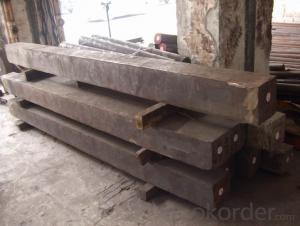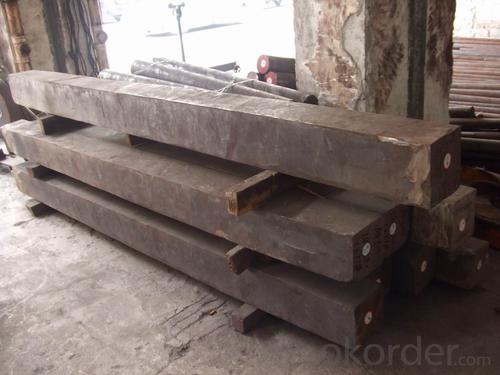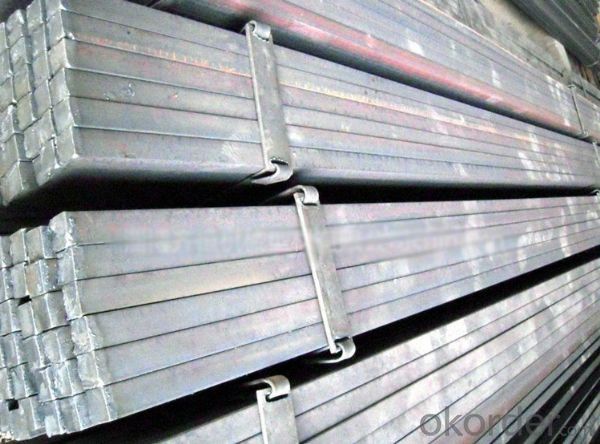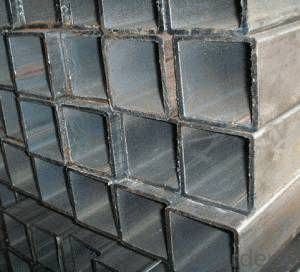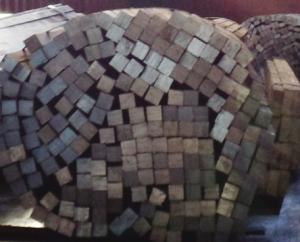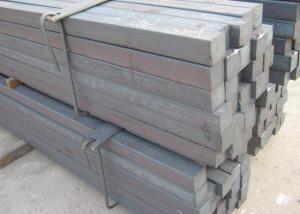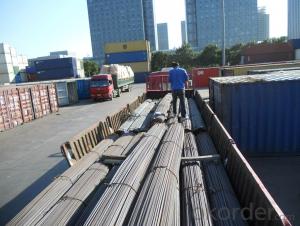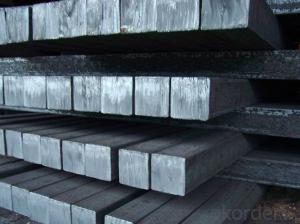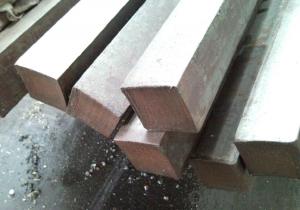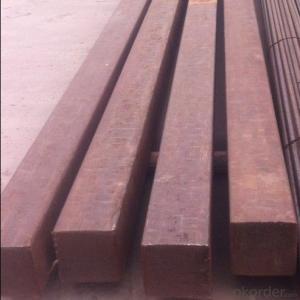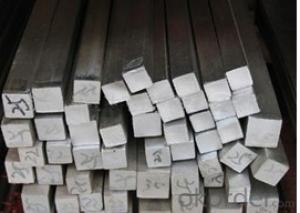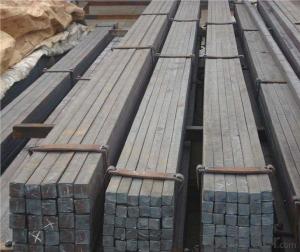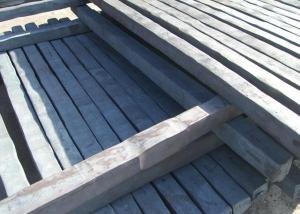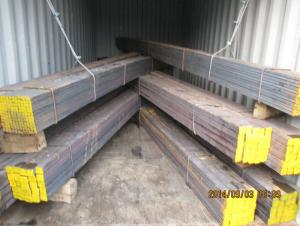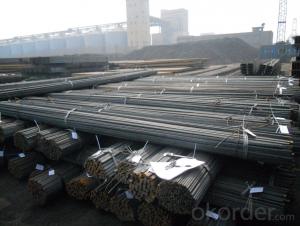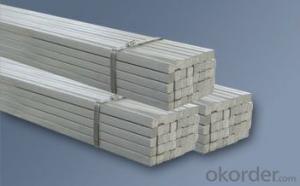14mm*1.54kg/m square bar for construction
- Loading Port:
- Tianjin
- Payment Terms:
- TT OR LC
- Min Order Qty:
- 25 m.t.
- Supply Capability:
- 100000 m.t./month
OKorder Service Pledge
OKorder Financial Service
You Might Also Like
Product Description:
There are two types of Square Bar, one is hot rolled square bar and other one is cold drawn square bar. Our principal products is hot rolled square bar. We dedicate to products with material Q195 and Q235. We offer products with high quality and low price.
Specifications of Hot-rolled Square Steel Bar:
-Standard: GB,
-Grade: Q195/Q235 or equivalent.
-Chemical Composition:
Standard | Grade | Element (%) | ||||
C | Mn | S | P | Si | ||
GB | Q195 | 0.06~0.12 | 0.25~0.50 | ≤0.050 | ≤0.045 | ≤0.30 |
GB | Q235B | 0.12~0.20 | 0.30~0.70 | ≤0.045 | ≤0.045 | ≤0.30 |
-Mechanical Properties:
Mechanical Properties | Grade | Steel diameter(mm) | |||
≤16 | 16~40 | 40~60 | 60~100 | ||
Yield Point Δs/MPa | Q195 | ≥195 | ≥185 | - | - |
Q235 | 235 | 225 | 215 | 205 | |
Tensile Strength | Q195 | 315~390 | |||
Q235 | 375~500 | ||||
Elongation δ5% | Q195 | ≥33 | ≥32 | - | - |
Q235 | 26 | 25 | 24 | 23 | |
Measures of Hot-rolled Square Steel Bar (Big measures):
(Section of Hot-rolled Square Steel Bar)
-Length of a side and Theoretical weight of Square Bar (Big measures).
Length of a side(mm) | Theoretical weight(kg/m) | Length of a side(mm) | Theoretical weight(kg/m) |
53 | 22.05 | 80 | 50.24 |
56 | 24.61 | 85 | 56.72 |
60 | 28.26 | 90 | 63.59 |
63 | 31.16 | 95 | 70.85 |
70 | 38.49 | 100 | 78.50 |
75 | 44.16 |
Notes:
1, The theoretical weights in the list, base on the density of 7.85 g/cm3.
2, Formula for theoretical weight of Square bar: a(length of a side) * a * 0.00785
3, The numbers with *mean that they are not regular or we don’t offer them.
-Regular length of Square Bar:
Steel | Length of a side (mm) | Length of steel (m) |
Normal steel | < 25 | 4~10 |
> 25 | 3~9 | |
Steel of high quality | All measure | 2~6 |
Tool steel >75 | 1~6 |
Usage/Applications of Hot-rolled Square Steel Bar:
-The Square Steel is normally used as structure steel.
-Row material for other structure steel like steel angles, channels, I-beams, H-beams, etc…
-Row material for steel pipes.
Packaging & Delivery of Hot-rolled Square Steel Bar:
-Packing Detail:
1, The products can be packed in bundles by steel wires.
2, The weight of each bundle no exceed normally 3 tons.
-Marks: We make tag marks and color marks for each bundle. The tag marks with white background and red company log will be tied up to each bundle. The information is usually including basic information of company and products like product name, specification, etc...and other information required by customers. As for color marks, we will paint both ends of each bundles to make sure that it will be more convenient for customers to distinguish theme from other products.
-Delivery Detail: 30~45 working days after receive buyer’s T.T. or L/C.
Payment:
-Invoicing on theoretical weight or actual weight as customer’s request.
-FOB, CFR or CIF.
-Regular terms of payment:
1, 30% payment in advance, the remaining balance (70% payment) against the copy of B/L.
2, 30% payment in advance, the remaining balance (70% L/C) against the copy of B/L.
3, Negotiable.
-The payment terms will be written in contraction detailedly
- Q: Can a steel square be used for marking out dovetails?
- Yes, a steel square can be used for marking out dovetails. Its straight edges and right angles can help in accurately marking the angles and lines needed for creating dovetail joints. However, it is important to ensure that the steel square is properly aligned and adjusted to ensure precise measurements.
- Q: Can a steel square be used for marking out cuts on materials?
- Yes, a steel square can be used for marking out cuts on materials. Steel squares are commonly used in carpentry and other trades to ensure accurate and straight cuts by providing a right angle reference.
- Q: Can a steel square be used for measuring angles in tile work?
- Yes, a steel square can be used for measuring angles in tile work. Steel squares have a 90-degree angle that can serve as a reference point for measuring and marking angles accurately. However, it may not be as precise for measuring smaller or more complex angles compared to specialized tools like a protractor or angle finder.
- Q: How do you use a steel square to lay out a jack rafter?
- To use a steel square to lay out a jack rafter, you will need to follow a few steps. First, ensure that you have a proper understanding of the different markings and measurements on the steel square. The steel square typically consists of two arms, the longer one called the body and the shorter one called the tongue. These arms have various markings and notches that are essential for accurate layout. 1. Determine the pitch: The pitch is the slope or angle of the roof. Use the pitch scale on the steel square and align it with the desired pitch. This will help you determine the angle at which the jack rafter needs to be cut. 2. Find the length: Measure the horizontal distance from the ridge board to the wall plate where the jack rafter will be installed. Place the steel square on the edge of the rafter stock, ensuring the body aligns with the plumb (vertical) edge and the tongue aligns with the horizontal edge. The intersection of the tongue and a suitable number on the body will give you the length of the rafter. 3. Mark the plumb cut: With the determined length, use the square to mark the plumb cut at the end of the rafter. This cut will be perpendicular to the ridge board and should align with the layout line on the ridge board. 4. Mark the seat cut: The seat cut is where the rafter will rest on the wall plate. To mark it, place the square on the edge of the rafter stock with the tongue aligned with the plumb cut mark. Slide the square towards the body until it aligns with the desired pitch on the pitch scale. This will give you the angle for the seat cut. 5. Mark the bird's mouth: The bird's mouth is the notch that will allow the rafter to sit securely on the wall plate. Place the square on the lower end of the rafter, ensuring the body aligns with the plumb edge. Slide the square until the tongue aligns with the seat cut angle. Mark the notch where the tongue meets the rafter. 6. Cut and install: Use a saw to cut along the marked lines for the plumb cut, seat cut, and bird's mouth. Once cut, place the jack rafter in position, ensuring the bird's mouth fits snugly onto the wall plate. Secure the rafter by nailing it to the wall plate and the ridge board. By following these steps and accurately utilizing the markings on a steel square, you can effectively lay out and cut a jack rafter for your roofing project.
- Q: Can a steel square be used for measuring angles in metal roofing?
- Yes, a steel square can be used for measuring angles in metal roofing. Steel squares have a built-in protractor that allows for accurate angle measurements, making them a suitable tool for measuring and marking angles in metal roofing projects.
- Q: Can a steel square be used for constructing stairs?
- Certainly! When it comes to constructing stairs, a steel square proves to be quite handy. Known as a framing square or carpenter's square, this versatile tool is frequently employed in the realms of construction and woodworking. Its primary function revolves around gauging and delineating right angles, which makes it an excellent choice for precisely laying out stair stringers, calculating the rise and run of each step, and guaranteeing accuracy in cuts. Steel, being both durable and strong, renders it a dependable material for crafting stairs that can endure heavy foot traffic and offer steadfast stability for an extended period.
- Q: How accurate are steel squares for measuring?
- Steel squares are known for their high accuracy in measuring. Due to their sturdy construction and precise right-angle edges, they offer reliable measurements for various applications.
- Q: How do you use a steel square to determine the angle of a compound roundover cut?
- Follow these steps to determine the angle of a compound roundover cut using a steel square: 1. Identify the two surfaces that will be connected by the compound roundover cut, referring to them as Surface A and Surface B. 2. Place the steel square on Surface A, aligning one edge of the square with the surface's edge. Make sure the square is perpendicular to Surface A. 3. Extend Surface B towards the steel square, ensuring it overlaps with the blade of the square. 4. Take note of the intersection point between the blade of the steel square and Surface B. This point represents the angle at which the compound roundover cut needs to be made. 5. Measure the angle formed at the intersection point using a protractor or a digital angle finder. Record the measurement. 6. Transfer the angle measurement onto your workpiece by either marking it directly or replicating it with a bevel gauge. 7. Before proceeding with the compound roundover cut, double-check the accuracy of the angle measurement. Make adjustments to the square or re-measure if necessary. By utilizing a steel square in this manner, you can accurately determine the angle of a compound roundover cut, ensuring precise results in your woodworking or carpentry projects.
- Q: Can a steel square be used for door installation?
- Door installation can indeed make use of a steel square. Known by various names such as a framing square or carpenter's square, this versatile tool is commonly employed by carpenters and builders for a multitude of tasks, including door installation. Its primary function is to ensure that the door frame is both square and level, a crucial aspect of proper installation. By placing the steel square against the frame, one can easily assess the corners for squareness. Additionally, it can be utilized for marking and measuring the hinge mortises and other significant points throughout the installation process. Hence, a steel square is an indispensable tool that greatly aids in achieving a professional and precise door installation.
- Q: How do you use a steel square to measure and mark 303.75-degree angles?
- To use a steel square to measure and mark 303.75-degree angles, you would first align the long edge of the square with the reference line or surface. Then, you would rotate the square until the angle measures 303.75 degrees on the scale provided on the square. Finally, you can use a pencil or marking tool to mark the desired angle accurately.
Send your message to us
14mm*1.54kg/m square bar for construction
- Loading Port:
- Tianjin
- Payment Terms:
- TT OR LC
- Min Order Qty:
- 25 m.t.
- Supply Capability:
- 100000 m.t./month
OKorder Service Pledge
OKorder Financial Service
Similar products
Hot products
Hot Searches
Related keywords
